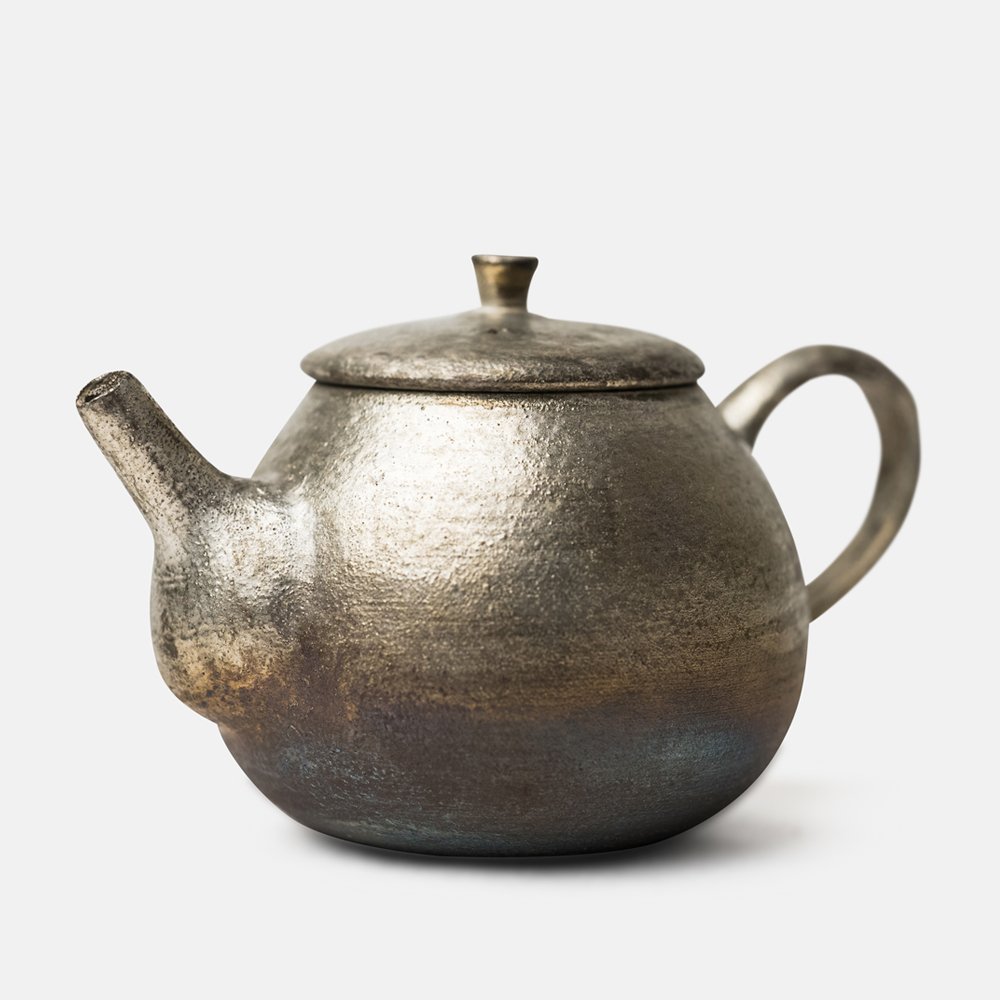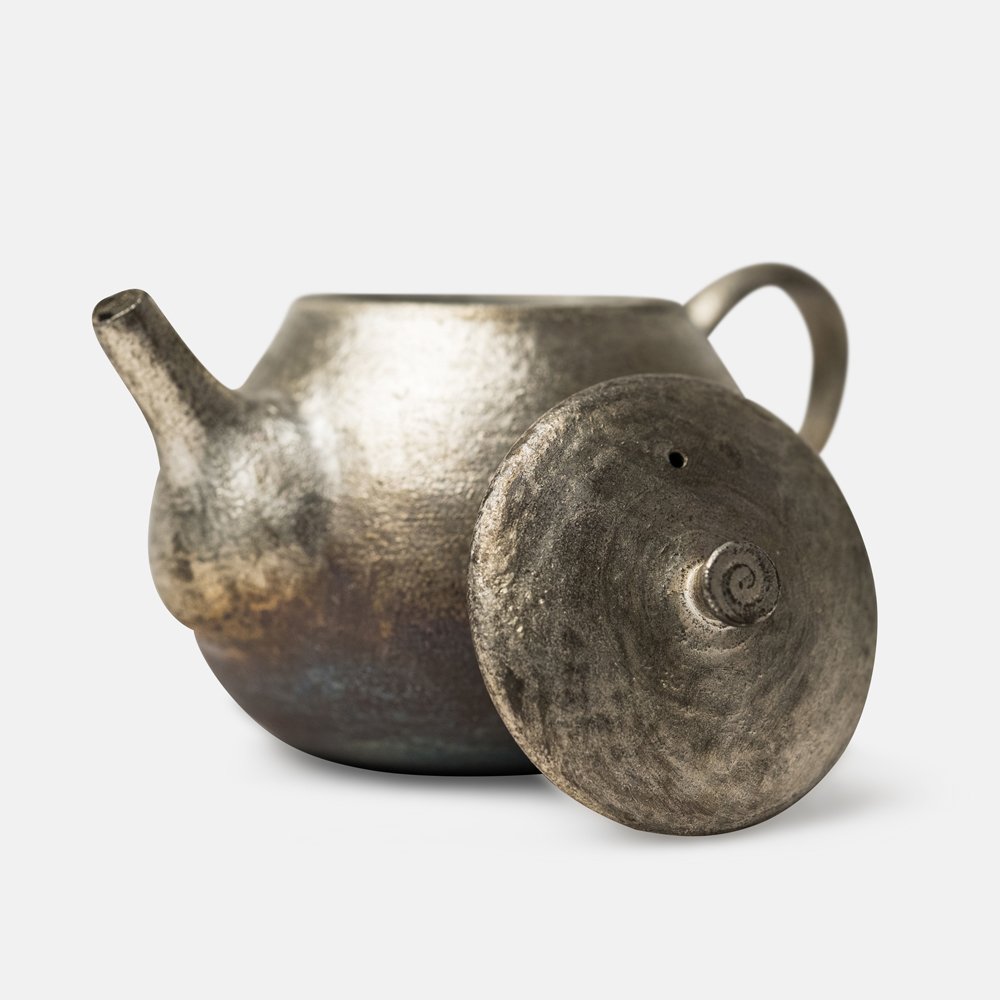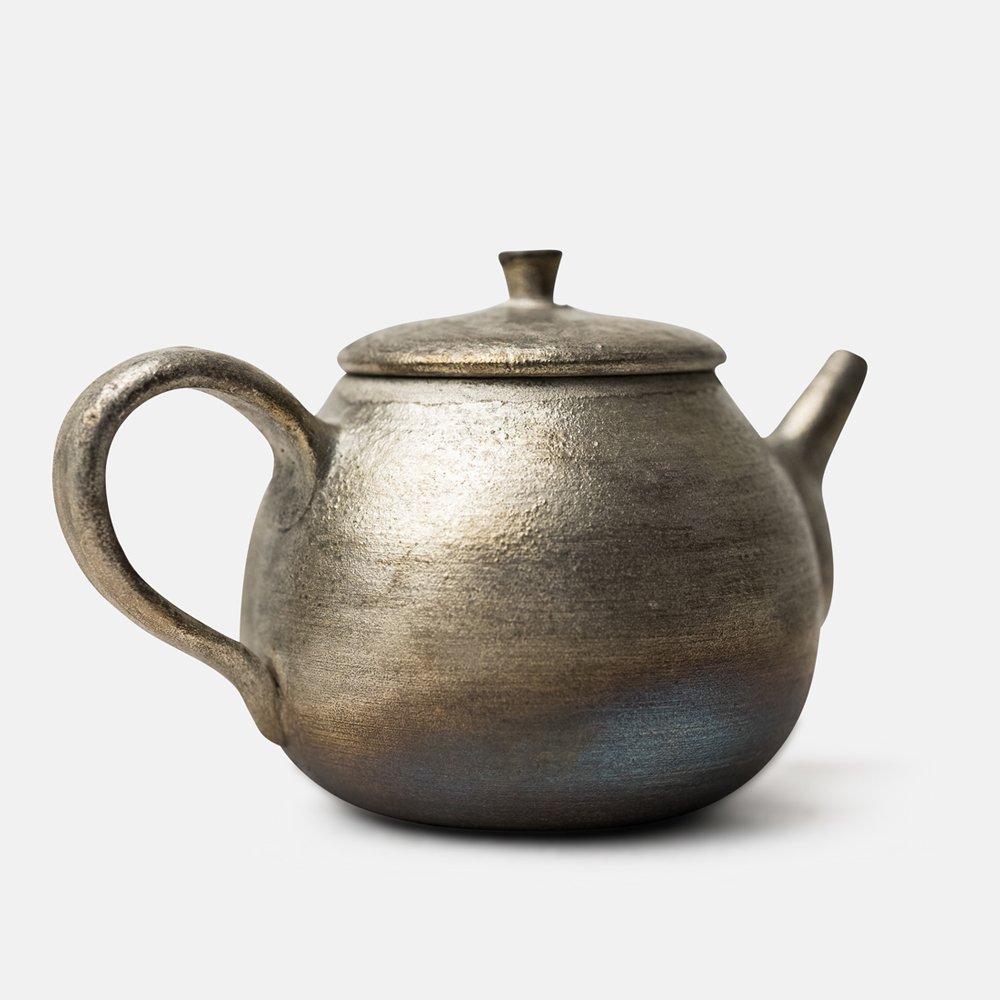Shibutaさん Bizen Silver Decorated Kyūsu (急須) Teapot (備前銀彩急須)
DETAILS
Handmade. Authentic Bizen. One of a Kind.
Bizen Silver Decorated Teapot, from the hands of Bizenyaki potter Shibutaさん. Perfect for brewing loose leaf teas to extract the full complexity of flavor. This piece includes a true metallic silver finish.
Bizen-yaki: Bizen-yaki is a traditional Japanese ceramic style from Okayama, Japan. Often unglazed, and red-pine wood fired for weeks, Bizen is said to change the flavor of the drinks held within.
🏆 Awarded Producer
Multiple showings and recognition in the ceramic arts.
DETAILS
Handmade. Authentic Bizen. One of a Kind.
Bizen Silver Decorated Teapot, from the hands of Bizenyaki potter Shibutaさん. Perfect for brewing loose leaf teas to extract the full complexity of flavor. This piece includes a true metallic silver finish.
Bizen-yaki: Bizen-yaki is a traditional Japanese ceramic style from Okayama, Japan. Often unglazed, and red-pine wood fired for weeks, Bizen is said to change the flavor of the drinks held within.
🏆 Awarded Producer
Multiple showings and recognition in the ceramic arts.
DETAILS
Handmade. Authentic Bizen. One of a Kind.
Bizen Silver Decorated Teapot, from the hands of Bizenyaki potter Shibutaさん. Perfect for brewing loose leaf teas to extract the full complexity of flavor. This piece includes a true metallic silver finish.
Bizen-yaki: Bizen-yaki is a traditional Japanese ceramic style from Okayama, Japan. Often unglazed, and red-pine wood fired for weeks, Bizen is said to change the flavor of the drinks held within.
🏆 Awarded Producer
Multiple showings and recognition in the ceramic arts.
Authentic Bizenyaki 備前焼 from (Okayakama) Imbe, Bizen.
The world’s most prized and rare unglazed Ceramic art form. Renowned for its ability to alter the taste of coffee, tea, sake, and Beer.
Bizenware is typically unglized, with many of the colors and patterns coming from two weeks of Firing.
Noticeably changes the taste of liquids such as Sake, Beer, Coffee, and Tea.
Only found within the small village of Imbe, Bizen. To be Bizenware, it can not be made anywhere else.
All Bizenware is 100% handmade by local artists.
-
Bizenware is a form of unglazed Japanese pottery only found in Imbe, Bizen.
Nearly every aspect of Bizen is wholly unique from other forms of ceramic arts.
Only clay from dug from a depth of 3-5 meters under local Bizen rice-fields are used.
The clay is left to age from 2 to 30 years.
The pottery is made by the same generations of pottery families with a 1,000-year history and is one of the 5 oldest kilns in Japan.
Firing occurs 1-2 times a year and takes over 14 days to complete using over 10 tons of Japanese Red Pine.
Generally, varied colors and natural “glaze” are the results of chemical changes during the firing.
Bizen has produced more Japanese living treasures than any other Ceramic art form.
-
1980 Graduated from Faculty of Art and Design,
Musashino Art University.(major interior design)
1991 Won a prize at Plastic Arts for the Tea Ceremony Exhibition,
Tanabe Museum of Art and accepted in the exhibition.
( Accepted 8 times in the exhibition)
Accepted in one more in the exhibition)
1992 Won a prize at Plastic Arts for the Tea Ceremony Exhibition,
Tanabe Museum of Art.
1993 Accepted in Pottery Biennale.
( Accepted two times in the exhibition)
Accepted in Japan Pottery Exhibition.
2000 Invited to exhibit at Chanoyu-Contemporary Exhibition,
Helsinki Museum of Art, Finland.
2013 Build a Anagama kiln in France.
Exhibition and lecture
at Musee-National-Adrien-Dubouche Limoges.
Bizen exhibition at the Paris gallery Hayasaki.
2015 Invited to the ceramics symposium of the University
of Paris organized by INHA.
exhibition at the Paris gallery Hayasaki.
2016 Invited to ARTCERAM2 BIENNALE at Sevres Paris.
2018 Japonismes2018 France
exhibition at the Paris gallery Hayasaki.
2019 Solo exhibition at Taipei Pottery Perception Gallery.Solo exhibition every year in Bizen Gallery Aoyama and Mugenan Ginza Tokyo.
Solo and group Exhibition at many places.
-
To make a fresh and smooth bowl of Usucha or Koicha, follow our whisking instructions.
Sourcing Details
Producer Details
SHIBUTAさん’s Artist Statement
Our lives are deeply intertwined with nature, and my creations are born from this observation. Bizenyaki is a ceramic art that consists of four natural elements: earth, fire, water, and wind.
Understanding the characteristics of these four elements, and working in harmony with them, is the essence of my creative process. My focus includes dichotomies: between Japan and the West, Light and Shadow, Tradition and Modernity.
FIRING DETAILS
Bizen Clay & Anagama firing
Shibutaさん uses local Bizen clay, which he digs and ages within Imbe, Okayama, Japan. Handling of the claw determines the final texture and color of the work. Firing is then done in a long tunnel kiln known as an Anagama (穴窯.) Natural factors, such as the weather, season, wood type and more determine the ultimate look of the pottery.
REGION DETAILS
IMBE, JAPAN
In 1948, Japanese ceramic scholar Fujio Koyama identified six historic kilns of great importance to Japan’s ceramic heritage: Bizen, Shigaraki, Seto, Tokoname, Echizen, and Tamba. Each of these kilns has over 1,000 years of history and is collectively known as the Rokkoyo (六古窯), or "Six Ancient Kilns." In 2017, they were officially designated as Japanese Heritage sites.
Imbe, the birthplace of Bizen pottery, preserves traditional techniques, especially Yakishime—unglazed pottery that is fired for several days to weeks at high temperatures. The distinctive patterns and colors of Bizen pottery are the result of natural chemical reactions between the wood ash, clay, and intense heat. These reactions can produce earthy reds, yellows, blacks, and even occasional hints of the highly prized and rare blue.
While contemporary Bizen artists often explore new designs, forms, and techniques to push the art form forward, they do so with a profound respect for the traditions that have upheld Bizen’s status as one of the esteemed Rokkoyo.








